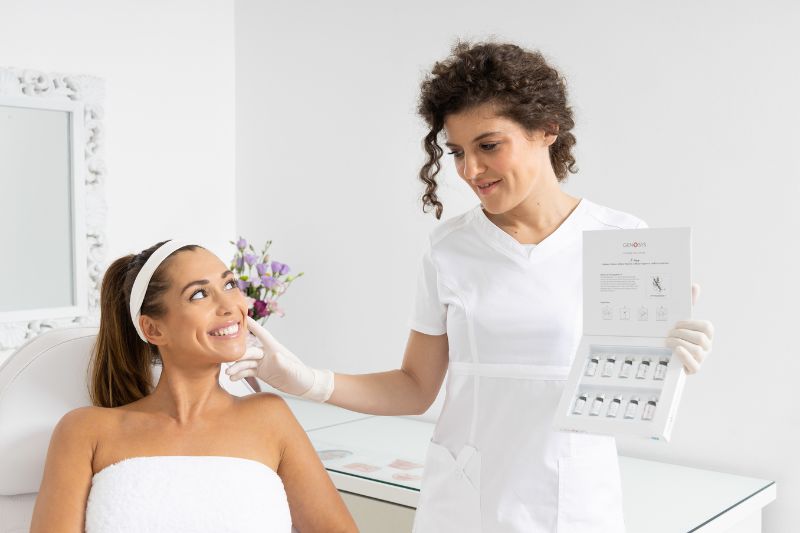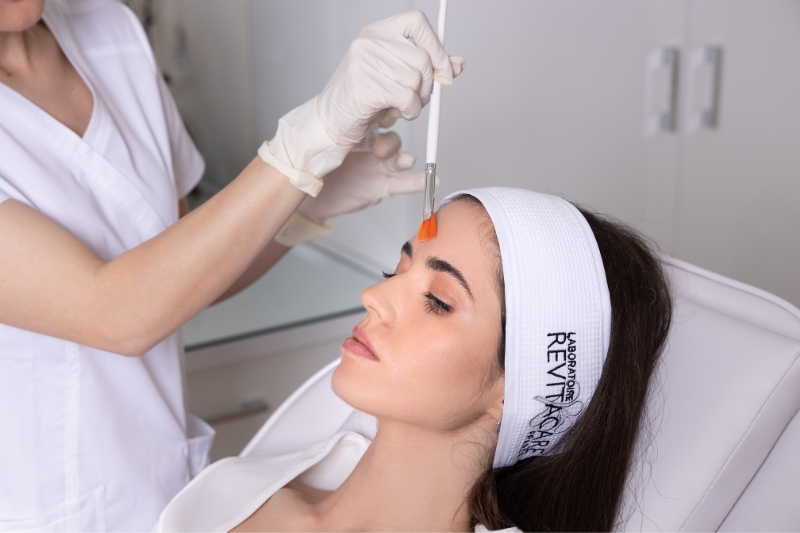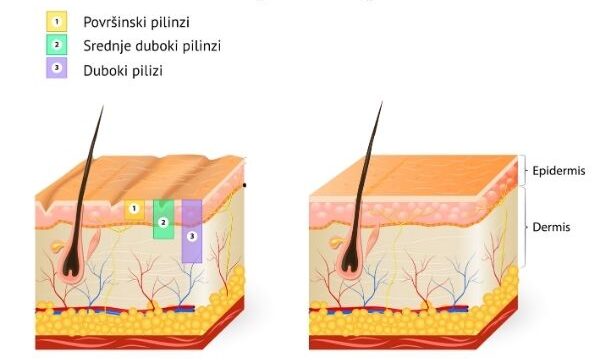Chemical peels are excellent option for addressing a variety of skin issues, including dark spots, acne scars, acne, hyperpigmentation, as well as for achieving effective skin rejuvenation and regeneration. It is a versatile procedure that offers multiple benefits for improving the overall appearance and condition of the skin.
Chemical peeling is a highly effective treatment method renowned for its ability to naturally regenerate the skin, address various skin concerns, enhance skin quality, and provide a rejuvenated appearance. Its remarkable benefits have garnered significant interest not only in our practice but also in aesthetic clinics worldwide. To provide you with comprehensive information and alleviate any doubts, we have provided detailed answers to common questions regarding chemical peeling. Discover what a chemical peel entails, the different types available, what results you can anticipate after the treatment, and much more.

Why chemical peels are so popular?
Many of you may wonder if at-home mechanical peeling, regular cleansing, and the use of appropriate creams and serums are sufficient to achieve radiant and luminous skin. It is important to note from the outset that creams and serums primarily act on the skin’s surface. The outermost layer of the skin, known as the “dead” layer, hinders the penetration of active ingredients into the deeper layers. Although creams and serums contain active substances, they cannot effectively reach the deeper layers of the skin, where these substances are most beneficial.
Chemical peeling, on the other hand, involves the removal of the superficial layer of the skin, thereby promoting skin regeneration, enhancing skin quality, and stimulating the production of collagen and elastin, which are crucial for a youthful appearance.
What are chemical peels?
Chemical peeling involves the application of chemical agents to the skin, resulting in accelerated exfoliation. This process serves a dual purpose – it removes the superficial layers of the skin and stimulates the release of cytokines, growth factors, and collagen synthesis, which contribute to skin rejuvenation.
Exfoliation of the skin through chemical peels yields significant results in various skin concerns, including skin refreshment, rejuvenation, and the resolution of issues such as acne, hyperpigmentation, acne scars, and other imperfections. By removing blackheads, clearing clogged pores, and reducing acne-causing bacteria, exfoliation plays a crucial role in improving the skin’s appearance. Common aesthetic problems such as uneven complexion, hyperpigmentation, enlarged pores, acne scars, and stretch marks can be effectively addressed through the powerful action of chemical peeling, resulting in deep skin rejuvenation.

Indications for chemical peels
Chemical peeling is highly effective in addressing various skin concerns, including:
- Uneven complexion and texture: Chemical peels can help smoothen the skin’s texture, reduce roughness, and improve overall skin tone, resulting in a more even complexion.
- Enlarged pores: Chemical peels can help minimize the appearance of enlarged pores by removing excess oil, dirt, and debris from the skin, leading to a tighter and more refined pore appearance.
- Hyperpigmentation, spots, melasma, age spots: Chemical peels are beneficial in reducing the appearance of hyperpigmentation, dark spots, melasma, and age spots. The exfoliation process removes the upper layers of pigmented skin, promoting a more even skin tone.
- Acne: Chemical peels can effectively treat acne by exfoliating the skin and unclogging pores, reducing the accumulation of acne-causing bacteria. They also help fade acne scars and promote skin healing.
- Stretch marks: While chemical peels may not completely eliminate stretch marks, they can help improve their appearance by stimulating collagen production and promoting skin regeneration.
What does treatment look like?
The treatment begins with facial cleansing to remove impurities and prepare the skin. Next, acids are applied to the skin and left to act for approximately ten minutes. Afterward, the acids are removed and a protective cream is applied. You can then resume your daily activities. It’s worth noting that this procedure is typically painless, although you may experience a temporary sensation of skin burning. In the days following the treatment, it is normal for the skin to peel as part of the regeneration process.
To protect your skin, it is essential to use a cream with a high level of sun protection, regardless of the season. Rest assured that your doctor will provide guidance on post-treatment home care to ensure proper healing and maintenance of your skin’s health.
What types of chemical peels are there?
There are various types of chemical peels available, which are chosen based on the specific skin concern being addressed and the desired depth of the peel. Peels can also differ in terms of the peeling agent used. They are typically categorized into shallow, medium, and deep peels based on their depth of penetration. The deeper the peel, the longer the recovery time, but the more significant the results. It’s important to note that the strength of a peel is not solely determined by the acid concentration in the solution, but also by the pH value of the solution. For instance, a 20% acid concentration from one brand may be several times more potent than a 70% acid concentration from another brand.

Chemical peels ( fruit acids)
Chemical peels with glycolic acid can be superficial when using concentrations of 20-40% or more intense when using higher concentrations of 50-70%. Glycolic acid peels are an excellent form of skincare and anti-aging. They remove superficial, dead skin cells and stimulate their renewal and collagen synthesis. At the same time, they clean pores, remove blackheads, accelerate acne treatment and reduce skin pigmentation. They can be used independently or as an introduction to other procedures, e.g. mesotherapy.
Mandelic (almond) acid is an ideal chemical peel for sensitive skin prone to irritation, skin with seborrhea, rosacea and acne. It is used as a surface peeling because its high molecular weight does not allow penetration into the deeper layers of the skin. Therefore, peeling with mandelic acid is without redness, irritation and peeling of the skin. It has an antibacterial and anti-inflammatory effect on the skin, regulates the work of the sebaceous glands, and helps in the treatment of acne.
Lactic acid does not cause redness or irritation, it is used for all types of skin as well as for sensitive skin. It has a mild keratolytic effect – it dissolves the thickened surface layer of the skin, removes dead skin cells and stimulates its renewal. It is also used in the removal of hyperpigmentation and melasma, as it simultaneously blocks the enzymes that are essential for the synthesis of melanin and encourages it’s even spread. Lactic acid has an antibacterial effect, and can be used for acne-prone skin. In combination with other acids, it is used for photodamaged skin as well as for stimulating the synthesis of collagen and elastin.
Pyruvic (grape) acid is intended for dehydrated, mature and oily skin, as well as for the removal of hyperpigmentation, wrinkles and signs of photoaging. This medium-deep peeling activates the cells of the middle layer of the skin, restores collagen and elastin, which achieves a firm appearance of the skin and reduces fine lines. In addition to the antiaging effect, it has a strong antibacterial and comedonolytic effect – it removes comedonal acne, superficial keratitis and flat warts.
Chemical peeling with retinoic acid is the ideal peeling for rejuvenating and hydrating the skin, evening out its texture and complexion. Retinol is a form of vitamin A that, thanks to its small molecular size, penetrates into the deeper layers of the skin and stimulates the production of collagen, the growth and renewal of skin cells. This slows down aging and reduces the appearance of fine lines and wrinkles, increases skin elasticity and slows down the breakdown of collagen. This acid is excellent in helping to clean pores and reduce the appearance of acne.
Kojic acid is a chemical peel that is used to whiten the skin, remove hyperpigmentation and blemishes. Hyperpigmentation is a very widespread phenomenon, it is caused by excessive production of melanin and the causes are numerous: excessive exposure to the sun, aging, hormonal influence, skin injuries. Kojic acid blocks the activity of the tyrosinase enzyme in the production of melanin, which prevents hyperpigmentation. Also, its antioxidant effect has been proven, which reduces the consequences of skin damage due to UV radiation and external pollution.
Citric acid has an antioxidant and antiaging effect, and it is also used to remove visible signs of photodamage to the skin. It works by exfoliating the top layer of dead skin cells, cleaning pores, and evens skin tone and texture. It can be used for all skin types, and it is an ideal peel for the care of oily skin. Due to the possible appearance of redness and irritation, citric acid is not recommended for sensitive skin and skin prone to allergies.
Salicylic acid has been known for more than 2,000 years in the treatment of skin diseases. In the first century AD, Pliny used willow bark, which is a source of salicylic acid, to remove corns and corns. It has been observed that salicylic acid reduces sebum secretion, cleans pores and has an anti-inflammatory effect. It is ideal for acne and oily skin, as well as seborrheic dermatitis. In higher concentrations, salicylic acid removes the top layer of the skin and stimulates its renewal, which makes the texture even, and the skin acquires a radiant and healthy appearance.

TCA PEEL – trichloroacetic acid
Trichloroacetic acid (TCA) peels, depending on the concentration, can be deep or medium deep peels.
This peel has great potential for both skin rejuvenation and removal/reduction of acne scars, enlarged pores and stretch marks. TCA peeling achieves exceptional results in rejuvenating prematurely aged skin due to solar radiation, removing blemishes and evening out the complexion. The concentration of the peeling ranges from 15-80% acid, and depending on the indication, we also choose the strength.
TCA peels are the main procedure for removing acne scars, but for a good effect, an adequate peeling technique is necessary, which implies stronger treatment of the scars and a sufficient concentration of trichloroacetic acid of at least 30% or 35%. The recovery period after the treatment is 7 days, and it is done in a series of 3-4 peelings, between which a gap of one month is desirable.
TCA peels are performed from the beginning of October to the end of March due to weaker UV radiation in order to avoid the appearance of hyperpigmentation and spots. Learn more about TCA peeling here.
Phenol peel
Phenolic peeling is a chemical peel that penetrates deep into the layers of the skin, removing imperfections such as photodamage, deep wrinkles and furrows, age spots and acne scars. It gives more impressive results compared to other peels, but side effects such as changes in skin pigmentation and texture are possible. Therefore, it is necessary that this procedure be performed only by doctors with experience.
A brief overview of the most important acids
| Glycolic | Salicylic acid | Retinoic | TCA | |
|---|---|---|---|---|
| Exfoliation | YES | YES | YES | YES |
| Acne | YES | YES | YES | NO |
| Antiaging effect | YES | NO | YES | YES |
| Hyperpigmentation | YES | NO | YES | YES |
| Pores | YES | YES | YES | YES |
| Acne scars, scars | NO | NO | NO | YES |
| Synthesis of collagen | YES | NO | YES | YES |
Chemical peels – what are the effects?
- The skin is regenerated, appearing fresher, shinier, and more radiant.
- Dry skin is hydrated, allowing for deeper penetration of moisturizing products.
- Fine lines and wrinkles become less visible.
- Stretch marks and acne scars diminish in appearance.
- The complexion becomes more uniform, and the quality and texture of the skin visibly improve.
- Acne, blackheads, and oily skin are reduced.

Frequently asked questions
prices and additional questions
The price of chemical peels varies depending on the type of peel used and whether only the face area or the face, neck and décolletage are treated. If you have additional questions or want to book an appointment, please call us at 060/345-0304 or write at estetikabgd@gmail.com.
